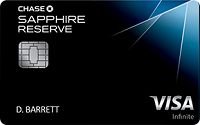
Sapphire Reserve vs. Altitude Reserve Head to Head
Last year Chase made waves with the launch of a premium credit card called the Sapphire Reserve. In many ways that card was a gamechanger since it introduced new features/benefits and also put pressure on Amex to change their premium offerings.
On May 1, U.S. Bank is looking to get on board with the introduction of a premium card of their own. It is called the Altitude Reserve and I think it has amazing potential. With that said, Sapphire Reserve is the current king of the block, so let’s see how they stack up.
Sign-Up Bonus
Both of these cards come with a similar bonus:
- Altitude Reserve: 50,000 points after $4,500 spend in the first 3 months.
- Sapphire Reserve: 50,000 points after $4,000 spend in the first 3 months.
WINNER: Sapphire Reserve
Sapphire Reserve launched with a 100K bonus, but it has since dropped to just 50K. Either way the Sapphire Reserve is the winner here due to the fact that it earns Ultimate Rewards which can be transferred to travel partners. More flexibility = more value.
Bonus Categories
Both cards have generous 3X bonus categories:
- Altitude Reserve
- Earn 3x points per $1 spent on eligible net mobile wallet purchases using Apple Pay, Samsung Pay, Android Pay or Microsoft Wallet.
- Earn 3X points per $1 spent on eligible net travel purchases made directly with airlines, hotels, car rental companies, taxis, limousines, passenger trains and cruise line companies.
- Sapphire Reserve
- 3X Points on travel and dining worldwide.
WINNER: Altitude Reserve
While U.S. Bank’s premium card has a much more restrictive definition of travel, it makes up for it with what has the potential to be the best bonus category ever! Being able to earn 3X on mobile payments opens up so much potential for earning with this card and you earn 3X when using mobile payment apps both in-store and online.
Points Earned
Altitude Reserve: Points can be used for cash back, gift cards and merchandise at an unknown value. (Max $.01 per point). Points can be used to book travel at 1.5 cents each.
Sapphire Reserve: This card earns Ultimate Rewards points which can be transferred to travel partners such as United & Hyatt. Additionally points can be used to book travel at a value of 1.5 cents each.
WINNER: Sapphire Reserve
There really isn’t a contest here. Ultimate Rewards are the best flexible points currency out there and Sapphire Reserve gives you access to them. Unlike U.S. Bank’s points which have a limited value outside of travel redemptions, you can do a lot with the points earned on a Sapphire Reserve.
Travel Credit
Both of these cards reimburse you for travel expenses throughout the year.
- Altitude Reserve: Earn up to $325 every cardmember year in automatic statement credits for travel purchases made directly from airlines, hotels, car rental companies, taxis, limousines, passenger trains and cruise lines.
- Sapphire Reserve: Each calendar year, automatically receive up to $300 in statement credits as reimbursement for travel purchases such as airfare and hotels charged to your card.
WINNER: Sapphire Reserve
The Sapphire Reserve wins this one, but barely. First, Sapphire Reserve’s credit seemingly covers more stuff from the terms, although we don’t know how Altitude Reserve’s credit will work in practice. Both credits are automatically issued which is nice, but Sapphire Reserve’s credit is issued per “calendar year” while Altitude Reserve’s is per “cardmember year”. This means you can receive the credit twice in the first year with the card.
Lounge Access
Both premium offerings give you lounge access.
Altitude Reserve: Priority Pass Select with 4 free visits per year including one guest.
Sapphire Reserve: Priority Pass Select with unlimited free vists per year including unlimited guests (within reason).
WINNER: Sapphire Reserve
This one is pretty self explanatory. If you plan to use lounge access with any frequency, Altitude Reserve is a big let down.
Car Rental Insurance (Plus Travel & Purchase Protection)
- Altitude Reserve: Primary CDW insurance on vehicles with an MSRP of up to $75,000
- Sapphire Reserve: Primary CDW insurance on vehicles with an MSRP of up to $75,000
WINNER: Tie
Both of these cards have the exact same primary CDW coverage. Their travel and purchase protection benefits are also virtually the same since those benefits come from Visa Infinite (Both of these cards are considered Visa Infinite products.)
Annual Fee
- Altitude Reserve: $400 per year plus $75 for additional cardholders
- Sapphire Reserve: $450 per year plus $75 for additional cardholders
WINNER: Sapphire Reserve
The Sapphire Reserve does have slightly smaller travel credit and a $50 higher annual fee, but that isn’t the whole story. With the Sapphire Reserve you get more flexible points, the ability to receive the travel credit twice in the first year and unlimited lounge access. Also, with the Sapphire Reserve for $75 additional cardholders get their own lounge access while that isn’t the case with Altitude Reserve.
Overall Winner
Bottom Line
In the battle of Altitude Reserve vs. Sapphire Reserve, I think Sapphire Reserve does come out on top in just about every way. With that said, big spenders are going to do very very well with Altitude Reserve and its Mobile Wallet bonus category. In fact, I think the Mobile Wallet category is a true gamechanger when it comes to earnings and for that reason I will be picking one up! Now, the big question remains whether 3X Mobile Wallet will remain or if it will go away like the “Bonus Award Night” on the Club Carlson credit card.
Are you planning to pickup an Altitude Reserve when it comes out on May 1? Do you have a Sapphire Reserve? Please share your thoughts in the comments.
Lower Spend - Chase Ink Business Preferred® 100K!


Learn more about this card and its features!
Opinions, reviews, analyses & recommendations are the author’s alone, and have not been reviewed, endorsed or approved by any of these entities.






[…] Airlines, hotels, car rental companies, taxis, limousines, passenger trains and cruise lines. This is definitely one of the best, the travel credit is incredibly easy to use and the credit is only $75 less than the annual fee. There have been issues with shutdowns, so be sure to meet the minimum spend organically. Details here. […]
Two parts of this post need to be cleared up (or are blatantly bias):
1. Travel Credit needs to either go to the Altitude Reserve OR needs to be a tie. $25 is $25, and unless you count the first calendar year, Altitude wins. If you count the first year (and a lot of tracking work) then it can be a tie.
2. Annual fee goes to the Altitude Reserve. It is $50 cheaper PER YEAR. No idea why the CSR won that category.
Regardless of the total outcome, this is a lot closer than the post shows. Really, the only thing the CSR has over the Altitude is the transferable points. Which, in all honesty, nobody knows how the altitude points system will work. Most are assuming it will be similar to FlexPoints.
Hey Tim. This post contains my analysis and comparison of the two cards and I welcome your opinion. As you admit I do present the correct facts and everyone is free to form their own opinions based on these facts. I am merely sharing my thoughts and analysis.
We do know how these points will work and you can find that info in my FAQ post linked to at the top of this one. There will be NO transfer partners, the points cannot be transferred out to FlexPerks and the maximum value will be 1.5 cents each for travel and less for cash/gift cards/merchandise.
Thanks for the reply Shawn. I am more than fine with giving an opinion on which card is better, that is what this site is for. However, I find it slightly misleading to give the the winner of an objective category, such as “annual fee,” to the card that has the higher annual fee.
The real reason the Chase Sapphire reserve wins is because of the ultimate rewards travel program. There is such a wide variety and huge selection to worldwide lodging through this program. I’ve use the ultimate rewards for lodging in Spain, Portugal, France, Italy, the Netherlands, as well as throughout Canada and United States. When traveling, I often book the hotel the day before and I have found availability in small towns and villages as well as in large cities. It is truly a great travel rewards program.
Without transfer partners I don’t think this card stands much chance. It’s just Barclay Arrival all over again
Get both.
This is great, but with respect to Annual Fee as its own category, you simply picked the wrong winner.
A card with a lower fee is better and a lower net cost is better. Period.
I agree with Mark. The reasons for picking the CSR as the winner are for other categories, not truly relevant to the AF. Otherwise solid review.
I have the Chase Freedom, the Chase Sapphire Preferred (probably going to product switch to Freedom Unlimited when my annual renewal comes up for the CSP), and the Chase Sapphire Reserve. I’ve decided to consolidate all my points earning into Chase because a little with AMEX and a little with Costco (4% on gas is awesome but you wait a year to get your rebate) just doesn’t help much unless all you are interested in is in cash back.
For that reason alone, the Reserve beats the new US Bank card for me.
If you’re over 5/24 (like me ) and can’t get the Sapphire Reserved, the Altitude is a-go!
Isnt the CSR PP unlimited guests, not 2 per visit?
You are correct. The post has been fixed.
Another factor: the issuer.
Chase vs. US bank, which one doesn’t often downgrade card benefits 😀
They both have a cloudy history of cutting benefits unfortunately.
The CSR definitely comes out on top. With the variety of transfer partners and the increased earning potential when coupled with the Freedom and Freedom Unlimited, it is still #1.
The 3x on mobile payments and the gogo passes are interesting benefits though. At least US Bank is trying to compete, which is more than AMEX is doing. Raising the AF by $100, throwing in some Uber coupons, and making the card metal are not competing.
The only knowledge of the Altitude Reserve that I have are from bloggers such as yourself so I don’t claim to be an expert. In general, I agree that the CSR is the better card but I think you may have been a bit biased in the comparison. In my opinion, since you’ve already discussed lounge access, flexible transfers and travel credit, you shouldn’t factor that in the annual fee. Also, the travel credit essentially makes this card a $75 per year card while the CSR is a $150 card, so I definitely think the new Altitude Reserve is a better card in that category. I was also a bit surprised that you listed the CSR as having better travel credit but I can see your reasoning if someone only wants the card for one year. I would argue though, that the Altitude Reserve is a better card to keep long term because of the net annual fee cost of $75